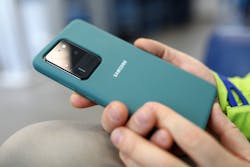3D sensing has been a very bright spot for laser revenues, growing from almost nothing a few years ago to over $1 billion today (see Laser Focus World’s 2021 Worldwide Laser Market Review and Forecast for full details). This amazing growth occurred largely because of Apple’s adoption of the technology in smartphones, and other phone manufacturers usually follow what Apple does. In this case, it looks like Samsung will reduce its use of 3D sensing technology because of high cost and claimed little usage by customers.
Before I was a laser analyst, I covered the market for smartphones and cellular infrastructure. Very different devices—hundreds of millions of lasers have been incorporated into smartphones for 3D sensing applications, measuring distance for camera focus, face textures for security, and providing forward-looking measurements for virtual-reality applications. At least that’s how Apple has been using lasers for 3D sensing applications. But remember, Apple phones come at a premium price with some new models selling for almost $1400.
Related: The Worldwide Market for Lasers: Market Review and Forecast 2021
But the market is not all about Apple. Samsung, often considered the leader in Android phones, offers a wide range of smartphones. And, there are the Chinese phone manufacturers such as Oppo, Vivo, Xiaomi, ZTE, Transsion, and Huawei as well. However, Huawei can no longer include Google applications preinstalled in their phones, which has hurt its sales, and LG, another phone manufacturer from South Korea, has recently announced it’s getting out of the phone business.
While Apple tends to lead in adding new smartphone features, with other phone manufactures adding these same features when the price comes down and the technology is more accessible. In many parts of the world, the price of Apple smartphones is unreachable, so these other phone manufacturers are doing their part in the phone ecosystem. For example, in Africa, 89% of phones sell for under $200, and over 50% of sales are phones under $100.
Phone manufacturers introduce new features such as 3D sensing, because they motivate consumers to purchase new phones. However, Apple phone buyers can be different than most other phone buyers. Samsung followed suit with the introduction of 3D sensing in its Pixel 4, in late 2019, as did the Xiaomi Mi Explorer, the Oppo Find X, and Huawei’s Mate 20 Pro. Then, Samsung introduced a rear-facing “lidar” in its Galaxy S10 5G, S20+, S20, and its ISOCELL Vizion 33D models, used for camera focus and virtual-reality applications.
However, Samsung dropped the sensor entirely in the Galaxy S21, and announced in April 2021 that its new Galaxy S22 won’t include the lidar sensor as well. While Apple still remains very committed to lidar sensors, this recent Samsung news is bound to slow adoption. CONTINUE READING >>>
About the Author
Allen Nogee
President, Laser Markets Research
Allen Nogee has over 30 years' experience in the electronics and technology industry including almost 20 years in technology market research. He has held design-engineering positions at MCI Communications, GTE, and General Electric, and senior research positions at In-Stat, NPD Group, and Strategies Unlimited.
Nogee has become a well-known and respected analyst in the area of lasers and laser applications, with his research and forecasts appearing in publications such as Laser Focus World, Industrial Laser Solutions, Optics.org, and Laser Institute of America. He has also been invited to speak at conferences such as the Conference on Lasers and Electro-Optics (CLEO), Laser Focus World's Lasers & Photonics Marketplace Seminar, the European Photonics Industry Consortium Executive Laser Meeting, and SPIE Photonics West.
Nogee has a Bachelor's degree in Electrical Engineering Technology from the Rochester Institute of Technology, and a Master's of Business Administration from Arizona State University.

